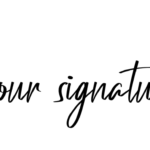Outlook is a popular email client used by many people for both personal and professional communication. One of the most important features of Outlook is the ability to create a custom signature that will automatically be added to the bottom of each email message. A signature can include text, images, and even links, and is a great way to add a personal touch to your emails, as well as share important information, such as your contact details or a tagline. In this article, we’ll go over the steps to add a signature in Outlook.
Step 1: Open Outlook
The first step is to open Outlook. You can do this by clicking on the Outlook icon in your Windows Start menu or by searching for Outlook in the search bar.
Step 2: Go to the File menu
Once Outlook is open, go to the File menu. In Outlook 2010 and earlier, this will be located at the top left corner of the window. In Outlook 2013 and later, this will be in the top left corner of the window and will be labeled “File”.
Step 3: Choose Options
From the File menu, select Options. This will open the Outlook Options window.
Step 4: Go to the Mail tab
In the Outlook Options window, select the Mail tab. This is where you can configure your email settings, including your signature.
Step 5: Scroll down to the Signatures section
In the Mail tab, scroll down to the Signatures section. Here, you’ll see any existing signatures you’ve created, as well as the option to create a new one.
Step 6: Create a new signature
To create a new signature, click on the New button. This will open the Signature Editor.
Step 7: Name your signature
Name your signature in the “New Signature” dialog box, then click on OK.
Step 8: Add your signature details
The Signature Editor is where you can add the details of your signature, such as your name, title, and contact information. You can also add an image, such as a logo, or a line of text to your signature. To add an image, simply click on the Image button and select the image you want to use.
Step 9: Format your signature
You can format your signature by using the formatting options in the Signature Editor, such as bold, italic, or underline. You can also change the font size and color if desired.
Step 10: Save your signature
Once you have added all the details to your signature and formatted it to your liking, click on OK to save it. Your new signature will now appear in the list of signatures in the Signatures section of the Mail tab.
Step 11: Choose your default signature
To choose your default signature, select the signature you want to use from the list in the Signatures section, then click on the Set as Default button. This will ensure that this signature is automatically added to the bottom of each email you send.
In conclusion, adding a signature in Outlook is a quick and simple process that can add a professional touch to your emails. By following these steps, you can create a custom signature that includes your name, contact information, and any other details you wish to include.
Example signatures you can use in Outlook
A signature in Outlook is a great way to personalize your emails and make a professional impression. A signature can include your name, title, contact information, and even a company logo. In this article, we’ll explore some examples of signatures you can use in Outlook to help you create a signature that fits your needs.
Basic Signature: A basic signature is a simple signature that includes your name, title, and contact information. This type of signature is best for individuals who prefer a minimalist approach to their email communications.
Example:
John Doe
Marketing Manager
johndoe@example.com
555-555-5555
Professional Signature: A professional signature is a more comprehensive signature that includes additional information such as a company name, website, and social media links. This type of signature is ideal for individuals who want to make a strong professional impression.
Example:
John Doe
Marketing Manager
ABC Company
www.abccompany.com
johndoe@example.com
555-555-5555
LinkedIn: linkedin.com/in/johndoe
Twitter: @johndoe
Creative Signature: A creative signature is a signature that includes a unique design element, such as a tagline, quote, or image. This type of signature is ideal for individuals who want to stand out and make a creative impression.
Example:
John Doe
Marketing Manager
ABC Company
www.abccompany.com
johndoe@example.com
555-555-5555
LinkedIn: linkedin.com/in/johndoe
Twitter: @johndoe
“Think Outside the Box”
Graphic Designer Signature: A graphic designer signature is a signature that includes an image, such as a company logo, or a custom design. This type of signature is ideal for individuals in creative industries, such as graphic design, who want to showcase their skills and make a visual impact.
Example:
[Company Logo]
John Doe
Graphic Designer
ABC Company
www.abccompany.com
johndoe@example.com
555-555-5555
LinkedIn: linkedin.com/in/johndoe
Twitter: @johndoe
In conclusion, a signature in Outlook is a powerful tool that can make a lasting impression on the recipients of your emails. By selecting a signature that best fits your needs and style, you can create a signature that effectively represents you and your brand. Whether you prefer a basic, professional, creative, or graphic designer signature, you can use the examples provided in this article to help you create a signature that stands out.



Add Comment